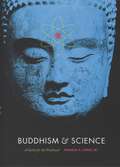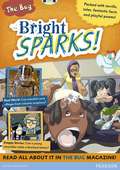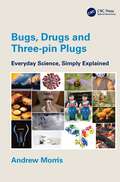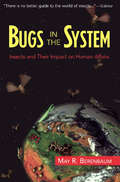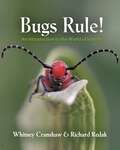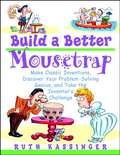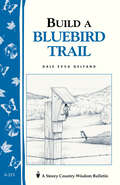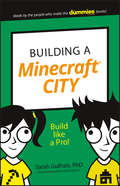- Table View
- List View
Buddhism and Intelligent Technology: Toward a More Humane Future
by Peter D. HershockMachine learning, big data and AI are reshaping the human experience and forcing us to develop a new ethical intelligence. Peter Hershock offers a new way to think about attention, personal presence, and ethics as intelligent technology shatters previously foundational certainties and opens entirely new spaces of opportunity. Rather than turning exclusively to cognitive science and contemporary ethical theories, Hershock shows how classical Confucian and Socratic philosophies help to make visible what a history of choices about remaking ourselves through control biased technology has rendered invisible. But it is in Buddhist thought and practice that Hershock finds the tools for valuing and training our attention, resisting the colonization of consciousness, and engendering a more equitable and diversity-enhancing human-technology-world relationship. Focusing on who we need to be present as to avoid a future in which machines prevent us from either making or learning from our own mistakes, Hershock offers a constructive response to the unprecedented perils of intelligent technology and seamlessly blends ancient and contemporary philosophies to envision how to realize its equally unprecedented promises.
Buddhism and Science: A Guide for the Perplexed (Buddhism and Modernity)
by Donald S. Lopez Jr.Beginning in the nineteenth century and continuing to the present day, both Buddhists and admirers of Buddhism have proclaimed the compatibility of Buddhism and science. Their assertions have ranged from modest claims about the efficacy of meditation for mental health to grander declarations that the Buddha himself anticipated the theories of relativity, quantum physics and the big bang more than two millennia ago. In Buddhism and Science, Donald S. Lopez Jr. is less interested in evaluating the accuracy of such claims than in exploring how and why these two seemingly disparate modes of understanding the inner and outer universe have been so persistently linked. Lopez opens with an account of the rise and fall of Mount Meru, the great peak that stands at the center of the flat earth of Buddhist cosmography—and which was interpreted anew once it proved incompatible with modern geography. From there, he analyzes the way in which Buddhist concepts of spiritual nobility were enlisted to support the notorious science of race in the nineteenth century. Bringing the story to the present, Lopez explores the Dalai Lama’s interest in scientific discoveries, as well as the implications of research on meditation for neuroscience. Lopez argues that by presenting an ancient Asian tradition as compatible with—and even anticipating—scientific discoveries, European enthusiasts and Asian elites have sidestepped the debates on the relevance of religion in the modern world that began in the nineteenth century and still flare today. As new discoveries continue to reshape our understanding of mind and matter, Buddhism and Science will be indispensable reading for those fascinated by religion, science, and their often vexed relation.
Buddhism and Science: A Guide for the Perplexed (Buddhism and Modernity)
by Donald S. Lopez Jr.Beginning in the nineteenth century and continuing to the present day, both Buddhists and admirers of Buddhism have proclaimed the compatibility of Buddhism and science. Their assertions have ranged from modest claims about the efficacy of meditation for mental health to grander declarations that the Buddha himself anticipated the theories of relativity, quantum physics and the big bang more than two millennia ago. In Buddhism and Science, Donald S. Lopez Jr. is less interested in evaluating the accuracy of such claims than in exploring how and why these two seemingly disparate modes of understanding the inner and outer universe have been so persistently linked. Lopez opens with an account of the rise and fall of Mount Meru, the great peak that stands at the center of the flat earth of Buddhist cosmography—and which was interpreted anew once it proved incompatible with modern geography. From there, he analyzes the way in which Buddhist concepts of spiritual nobility were enlisted to support the notorious science of race in the nineteenth century. Bringing the story to the present, Lopez explores the Dalai Lama’s interest in scientific discoveries, as well as the implications of research on meditation for neuroscience. Lopez argues that by presenting an ancient Asian tradition as compatible with—and even anticipating—scientific discoveries, European enthusiasts and Asian elites have sidestepped the debates on the relevance of religion in the modern world that began in the nineteenth century and still flare today. As new discoveries continue to reshape our understanding of mind and matter, Buddhism and Science will be indispensable reading for those fascinated by religion, science, and their often vexed relation.
Buddhism and Science: A Guide for the Perplexed (Buddhism and Modernity)
by Donald S. Lopez Jr.Beginning in the nineteenth century and continuing to the present day, both Buddhists and admirers of Buddhism have proclaimed the compatibility of Buddhism and science. Their assertions have ranged from modest claims about the efficacy of meditation for mental health to grander declarations that the Buddha himself anticipated the theories of relativity, quantum physics and the big bang more than two millennia ago. In Buddhism and Science, Donald S. Lopez Jr. is less interested in evaluating the accuracy of such claims than in exploring how and why these two seemingly disparate modes of understanding the inner and outer universe have been so persistently linked. Lopez opens with an account of the rise and fall of Mount Meru, the great peak that stands at the center of the flat earth of Buddhist cosmography—and which was interpreted anew once it proved incompatible with modern geography. From there, he analyzes the way in which Buddhist concepts of spiritual nobility were enlisted to support the notorious science of race in the nineteenth century. Bringing the story to the present, Lopez explores the Dalai Lama’s interest in scientific discoveries, as well as the implications of research on meditation for neuroscience. Lopez argues that by presenting an ancient Asian tradition as compatible with—and even anticipating—scientific discoveries, European enthusiasts and Asian elites have sidestepped the debates on the relevance of religion in the modern world that began in the nineteenth century and still flare today. As new discoveries continue to reshape our understanding of mind and matter, Buddhism and Science will be indispensable reading for those fascinated by religion, science, and their often vexed relation.
Buddhist Biology: Ancient Eastern Wisdom Meets Modern Western Science
by David P. BarashMany high-profile public intellectuals -- including "New Atheists" like Richard Dawkins, Daniel Dennett, and the late Christopher Hitchens -- have argued that religion and science are deeply antagonistic, representing two world views that are utterly incompatible. David Barash, a renowned biologist with forty years of experience, largely agrees with them, but with one very big exception: Buddhism. In this fascinating book, David Barash highlights the intriguing common ground between scientific and religious thought, illuminating the many parallels between biology and Buddhism, allowing readers to see both in a new way. Indeed, he shows that there are numerous places where Buddhist and biological perspectives coincide and reinforce each other. For instance, the cornerstone ecological concept -- the interconnectedness and interdependence of all natural things -- is remarkably similar to the fundamental insight of Buddhism. Indeed, a major Buddhist text, the Avatamsaka Sutra, which consists of ten insights into the "interpenetration" between beings and their environment, could well have been written by a trained ecologist, just as current insights in evolutionary biology, genetics and development might have been authored by the Buddha himself. Barash underscores other notable similarities, including a shared distrust of simple cause-and-effect analysis, an appreciation of the "rightness" of nature, along with an acknowledgment of the suffering that results when natural processes are tampered with. Buddhist Biology shows how the concept of "non-self," so confusing to many Westerners, is fully consistent with modern biology, as is the Buddhist perspective of "impermanence." Barash both demystifies and celebrates the biology of Buddhism and vice versa, showing in a concluding tour-de-force how modern Buddhism --shorn of its hocus-pocus and abracadabra -- not only justifies but actually mandates both socially and environmentally "engaged" thought and practice. Buddhist Biology is a work of unique intellectual synthesis that sheds astonishing light on biology as well as on Buddhism, highlighting the remarkable ways these two perspectives come together, like powerful searchlights that offer complementary and stunning perspectives on the world and our place in it.
Buddhist Biology: Ancient Eastern Wisdom Meets Modern Western Science
by David P. BarashMany high-profile public intellectuals -- including "New Atheists" like Richard Dawkins, Daniel Dennett, and the late Christopher Hitchens -- have argued that religion and science are deeply antagonistic, representing two world views that are utterly incompatible. David Barash, a renowned biologist with forty years of experience, largely agrees with them, but with one very big exception: Buddhism. In this fascinating book, David Barash highlights the intriguing common ground between scientific and religious thought, illuminating the many parallels between biology and Buddhism, allowing readers to see both in a new way. Indeed, he shows that there are numerous places where Buddhist and biological perspectives coincide and reinforce each other. For instance, the cornerstone ecological concept -- the interconnectedness and interdependence of all natural things -- is remarkably similar to the fundamental insight of Buddhism. Indeed, a major Buddhist text, the Avatamsaka Sutra, which consists of ten insights into the "interpenetration" between beings and their environment, could well have been written by a trained ecologist, just as current insights in evolutionary biology, genetics and development might have been authored by the Buddha himself. Barash underscores other notable similarities, including a shared distrust of simple cause-and-effect analysis, an appreciation of the "rightness" of nature, along with an acknowledgment of the suffering that results when natural processes are tampered with. Buddhist Biology shows how the concept of "non-self," so confusing to many Westerners, is fully consistent with modern biology, as is the Buddhist perspective of "impermanence." Barash both demystifies and celebrates the biology of Buddhism and vice versa, showing in a concluding tour-de-force how modern Buddhism --shorn of its hocus-pocus and abracadabra -- not only justifies but actually mandates both socially and environmentally "engaged" thought and practice. Buddhist Biology is a work of unique intellectual synthesis that sheds astonishing light on biology as well as on Buddhism, highlighting the remarkable ways these two perspectives come together, like powerful searchlights that offer complementary and stunning perspectives on the world and our place in it.
Budding Botanists: A Life Science Unit for High-Ability Learners in Grades 1-2
by Clg Of William And Mary/Ctr Gift EdBudding Botanists, a life science unit for grades 1-2, engages students in an investigation of plant life as they assume the role of botanists. Team members seek to understand the structure, nature, and life cycle of plants, and to answer questions such as “How can plants be used to fuel cars?”Winner of the 2008 NAGC Curriculum Studies Award, Budding Botanists was developed by the Center for Gifted Education at The College of William and Mary, to offer advanced curriculum supported by years of research. The Center's materials have received national recognition from the United States Department of Education and the National Association for Gifted Children, and they are widely used both nationally and internationally.Each of the books in this series offers curriculum that focuses on advanced content and higher level processes. The science units contain simulations of real-world problems, and students experience the work of real science by using data-handling skills, analyzing information, and evaluating results. The mathematics units provide sophisticated ideas and concepts, challenging extensions, higher order thinking skills, and opportunities for student exploration based on interest. These materials are a must for any teacher seeking to challenge and engage learners and increase achievement.Grades 1-2
Budding Botanists: A Life Science Unit for High-Ability Learners in Grades 1-2
by Clg Of William And Mary/Ctr Gift EdBudding Botanists, a life science unit for grades 1-2, engages students in an investigation of plant life as they assume the role of botanists. Team members seek to understand the structure, nature, and life cycle of plants, and to answer questions such as “How can plants be used to fuel cars?”Winner of the 2008 NAGC Curriculum Studies Award, Budding Botanists was developed by the Center for Gifted Education at The College of William and Mary, to offer advanced curriculum supported by years of research. The Center's materials have received national recognition from the United States Department of Education and the National Association for Gifted Children, and they are widely used both nationally and internationally.Each of the books in this series offers curriculum that focuses on advanced content and higher level processes. The science units contain simulations of real-world problems, and students experience the work of real science by using data-handling skills, analyzing information, and evaluating results. The mathematics units provide sophisticated ideas and concepts, challenging extensions, higher order thinking skills, and opportunities for student exploration based on interest. These materials are a must for any teacher seeking to challenge and engage learners and increase achievement.Grades 1-2
Budget Astrophotography: Imaging with Your DSLR or Webcam (The Patrick Moore Practical Astronomy Series)
by Timothy J. JensenHere are clear explanations of how to make superb astronomical deep-sky images using only a DSLR or webcam and an astronomical telescope – no expensive dedicated CCD cameras needed!The book is written for amateur astronomers interested in budget astrophotography – the deep sky, not just the Moon and planets – and for those who want to improve their imaging skills using DSLR and webcams. It is even possible to use existing (non-specialist astronomical) equipment for scientific applications such as high resolution planetary and lunar photography, astrometry, photometry, and spectroscopy. The introduction of the CCD revolutionized astrophotography. The availability of this technology to the amateur astronomy community has allowed advanced science and imaging techniques to become available to almost anyone willing to take the time to learn a few, simple techniques. Specialized cooled-chip CCD imagers are capable of superb results in the right hands – but they are all very expensive. If budget is important, the reader is advised on using a standard camera instead. Jensen provides techniques useful in acquiring beautiful high-quality images and high level scientific data in one accessible and easy-to-read book. It introduces techniques that will allow the reader to use more economical DSLR cameras – that are of course also used for day-to-day photography – to produce images and data of high quality, without a large cash investment.
Buffer Solutions (THE BASICS (Garland Science))
by Professor Rob Beynon J EasterbyAn indispensable guide to buffers and to understanding the principles behind their use. Helps the user to avoid common errors in preparing buffers and their solutions.A must for researchers in the biological sciences, this valuable book takes the time to explain something often taken for granted - buffers used in experiments. It answers the common questions such as: which buffer should I choose? What about the temperature effects? What about ionic strength? Why is the buffer with the biggest temperature variation used in PCR? It provides even the most experienced researchers with the means to understand the fundamental principles behind their preparation and use - an indispensable guide essential for everyone using buffers.
Buffer Solutions (THE BASICS (Garland Science))
by Professor Rob Beynon J EasterbyAn indispensable guide to buffers and to understanding the principles behind their use. Helps the user to avoid common errors in preparing buffers and their solutions.A must for researchers in the biological sciences, this valuable book takes the time to explain something often taken for granted - buffers used in experiments. It answers the common questions such as: which buffer should I choose? What about the temperature effects? What about ionic strength? Why is the buffer with the biggest temperature variation used in PCR? It provides even the most experienced researchers with the means to understand the fundamental principles behind their preparation and use - an indispensable guide essential for everyone using buffers.
Buffers for pH and Metal Ion Control
by D. PerrinThis book is intended as a practical manual for chemists, biologists and others whose work requires the use of pH or metal-ion buffers. Much information on buffers is scattered throughout the literature and it has been our endeavour to select data and instructions likely to be helpful in the choice of suitable buffer substances and for the preparation of appropriate solutions. For details of pH measurement and the preparation of standard acid and alkali solutions the reader is referred to a companion volume, A. Albert and E. P. Serjeant's The Determination of Ionization Constants (1971). Although the aims of the book are essentially practical, it also deals in some detail with those theoretical aspects considered most helpful to an understanding of buffer applications. We have cast our net widely to include pH buffers for particular purposes and for measurements in non-aqueous and mixed solvent systems. In recent years there has been a significant expansion in the range of available buffers, particularly for biological studies, largely in conse quence of the development of many zwiUerionic buffers by Good et al. (1966). These are described in Chapter 3.
Bug Club, Guided Comprehension, Y3: Magazine (PDF)
by Trish Cooke Paul Bright Christine Taylor-Butler Libby Martinez Cary Fagan Bill NagelkerkeBright Sparks! In Bright Sparks, read all about ideas that will make your head spin. How did a young genius make batteries for his village? What can people do when a volcano erupts? How can an inventive kitchen maid keep fruit fresh all year? How could you save an escaping mouse in silence? What do the zoo animals say when the keeper's away? Whatever you read, you'll be sure to find something that sets off the sparks of your own imagination!
Bugs, Drugs and Three-pin Plugs: Everyday Science, Simply Explained
by Andrew MorrisFor the millions who remain curious about the world around them, but gained little from science at school, this book offers a way forward. Based on live discussions with adults from all walks of life, each chapter begins with an everyday experience, like swallowing a pill or watching a bee on a flower. The main scientific ideas underlying each topic are then explored, so that understanding of a set of fundamental concepts builds up gradually throughout the book. In contrast to more traditional approaches to science learning, topics range freely across the subject areas. The story of Covid, for example includes aspects of biology, chemistry, mathematics and social behaviour. Plain English is used throughout and mathematical expressions are avoided. Key points are illustrated with clear diagrams and photographs. By drawing on questions and perspectives of ordinary people, the book offers an introduction to basic ideas in science as a whole, rather than any one particular subject. For the adult wishing to make good a gap in their understanding it provides a starting point for entering the rich world of popular science.
Bugs, Drugs and Three-pin Plugs: Everyday Science, Simply Explained
by Andrew MorrisFor the millions who remain curious about the world around them, but gained little from science at school, this book offers a way forward. Based on live discussions with adults from all walks of life, each chapter begins with an everyday experience, like swallowing a pill or watching a bee on a flower. The main scientific ideas underlying each topic are then explored, so that understanding of a set of fundamental concepts builds up gradually throughout the book. In contrast to more traditional approaches to science learning, topics range freely across the subject areas. The story of Covid, for example includes aspects of biology, chemistry, mathematics and social behaviour. Plain English is used throughout and mathematical expressions are avoided. Key points are illustrated with clear diagrams and photographs. By drawing on questions and perspectives of ordinary people, the book offers an introduction to basic ideas in science as a whole, rather than any one particular subject. For the adult wishing to make good a gap in their understanding it provides a starting point for entering the rich world of popular science.
Bugs In The System: Insects And Their Impact On Human Affairs
by May R. BerenbaumAn introduction to insect physiology, genetics and behaviour which looks at the interaction between humans and insects, and explores both the positive and negative aspects of the relationship.
Bugs Rule!: An Introduction to the World of Insects
by Whitney Cranshaw Richard RedakBugs Rule! provides a lively introduction to the biology and natural history of insects and their noninsect cousins, such as spiders, scorpions, and centipedes. This richly illustrated textbook features more than 830 color photos, a concise overview of the basics of entomology, and numerous sidebars that highlight and explain key points. Detailed chapters cover each of the major insect groups, describing their physiology, behaviors, feeding habits, reproduction, human interactions, and more. Ideal for nonscience majors and anyone seeking to learn more about insects and their arthropod relatives, Bugs Rule! offers a one-of-a-kind gateway into the world of these amazing creatures. Places a greater emphasis on natural history than standard textbooks on the subject Covers the biology and natural history of all the insect orders Provides a thorough review of the noninsect arthropods, such as spiders, scorpions, centipedes, millipedes, and crustaceans Features more than 830 color photos Highlights the importance of insects and other arthropods, including their impact on human society An online illustration package is available to professors
Bugs Rule!: An Introduction to the World of Insects
by Whitney Cranshaw Richard RedakBugs Rule! provides a lively introduction to the biology and natural history of insects and their noninsect cousins, such as spiders, scorpions, and centipedes. This richly illustrated textbook features more than 830 color photos, a concise overview of the basics of entomology, and numerous sidebars that highlight and explain key points. Detailed chapters cover each of the major insect groups, describing their physiology, behaviors, feeding habits, reproduction, human interactions, and more. Ideal for nonscience majors and anyone seeking to learn more about insects and their arthropod relatives, Bugs Rule! offers a one-of-a-kind gateway into the world of these amazing creatures. Places a greater emphasis on natural history than standard textbooks on the subject Covers the biology and natural history of all the insect orders Provides a thorough review of the noninsect arthropods, such as spiders, scorpions, centipedes, millipedes, and crustaceans Features more than 830 color photos Highlights the importance of insects and other arthropods, including their impact on human society An online illustration package is available to professors
BUiD Doctoral Research Conference 2022: Multidisciplinary Studies (Lecture Notes in Civil Engineering #320)
by Khalid Al Marri Farzana Mir Solomon David Aos AljubooriThis open access book presents selected contributions on a wide range of scientific and technological areas originating from the BUiD Doctoral Research Conference (BDRC 2022). It discusses the following topics: project management, macroeconomic factors, Fourth Industrial Revolution, agility, multiculturalism, diversity, inclusion, leadership, language, discourse analysis, curriculum, critical thinking, programming, online learning, and natural ventilation. The contributions reflect the multifaceted nature of the research in three academic disciplines, i.e., humanities, formal science, and applied science. This publication shares with its readers genuine research studies and reflections from practitioners on the current practice and understanding in the three academic disciplines. The significant findings of these studies have considerable educational, industrial, and economic implications.
Build a Better Mousetrap: Make Classic Inventions, Discover Your Problem-Solving Genius, and Take the Inventor's Challenge
by Ruth KassingerDiscover the secrets behind some amazing inventions! Through observation, experimentation, and perseverance, humansthrough the ages have managed to solve a whole array of perplexingproblems. These solutions have included such incredible inventionsas the parachute, the periscope, the solar water heater, thesuspension bridge, the stethoscope, and many more. Now, with Builda Better Mousetrap in hand, you too can experience your own Eureka!moments of inspiration and sharpen your problem-solving skills aswell, while you explore the history and science behind some of theworld's most exciting inventions. With this collection of fascinating, hands-on projects you'lldiscover the answers to such intriguing questions as: Who inventedthe hovercraft? Why is there a hole in the top of a parachute? Whatis an Aerobie and why does it fly so well? And you'll be encouragedto come up with your own awesome inventions. With easy-to-followinstructions on how to make everything from a rocket, to akaleidoscope, to a bottle organ, Build a Better Mousetrap is filledwith enough exciting projects and challenges to get you started ona lifetime of invention.
Build a Bluebird Trail: Storey's Country Wisdom Bulletin A-213 (Storey Country Wisdom Bulletin)
by Dale Evva GelfandConservationists across North America are working to help protect and support bluebirds, and you can do your part by creating a bluebird trail. This is simply a series of nesting boxes (anywhere from a few to a few thousand) set about 300 feet apart along a prescribed route. Dale Gelfand tells you what you need to know about bluebirds and their habits, and she shows you how to create and monitor an effective bluebird trail with well-designed nesting boxes.
Building a Global University: Successful Strategies and Case Studies
by Muralidhar MiryalaIn today’s globalized world, universities strive for excellence by aligning with the UN Sustainable Development Goals and competing in research. Global universities aim to benefit future generations and promote cooperation through exchange programs and research collaborations. This book emphasizes long-term planning, research focus, financial management, online learning, community engagement, and sustainable development goals as integral aspects of global university success. It also demonstrates that universities should prioritize societal values over rankings and popularity. The book is divided into two parts. The first part delves into the global strategies for establishing successful universities worldwide, highlighted by the vice-chancellors and presidents from renowned universities of the world. The second part discusses pilot projects and experiences from Shibaura Institute of Technology (SIT), along with successful case studies contributing to top-tier university development. It highlights that collaboration among universities, research institutions, and industries as well as leadership, strategic decision-making, and aligning missions with globalization goals are crucial for success. For any university in the world, including young universities aiming to become one of the top global universities within a specific timeframe and improve its ranking locally as well as globally, this is the right book as it showcases worldwide expert opinions and case studies.
Building a Global University: Successful Strategies and Case Studies
In today’s globalized world, universities strive for excellence by aligning with the UN Sustainable Development Goals and competing in research. Global universities aim to benefit future generations and promote cooperation through exchange programs and research collaborations. This book emphasizes long-term planning, research focus, financial management, online learning, community engagement, and sustainable development goals as integral aspects of global university success. It also demonstrates that universities should prioritize societal values over rankings and popularity. The book is divided into two parts. The first part delves into the global strategies for establishing successful universities worldwide, highlighted by the vice-chancellors and presidents from renowned universities of the world. The second part discusses pilot projects and experiences from Shibaura Institute of Technology (SIT), along with successful case studies contributing to top-tier university development. It highlights that collaboration among universities, research institutions, and industries as well as leadership, strategic decision-making, and aligning missions with globalization goals are crucial for success. For any university in the world, including young universities aiming to become one of the top global universities within a specific timeframe and improve its ranking locally as well as globally, this is the right book as it showcases worldwide expert opinions and case studies.
Building a Minecraft City: Build Like a Pro! (Dummies Junior)
by GuthalsThe coolest kid-friendly Minecraft projects If you have a Minecraft fanatic on your hands, you're about to be the most popular adult on the "block." Offering young Minecraft enthusiasts the ultimate sandbox experience, Building a Minecraft City gives kids aged 7 – 11 an outlet to enhance their love of the game and take their creative play to new heights. Brought to you by the trusted For Dummies brand, this kid-focused book offers step-by-step instructions and simple explanations for completing projects that will teach your child invaluable new skills—all while having a ton of fun! They'll gain confidence as they design and build truly impressive Minecraft structures, and you'll delight in watching them develop and refine their problem-solving skills as they work on their own. It's a win-win! Features a kid-friendly design that is heavy on eye-popping graphics Focuses on three basic projects that set young readers on the road to further exploration Boasts a small, full-color, accessible package that instills confidence in the reader Introduces basic engineering concepts to kids in a way they can understand Screen time can be as educational as it is fun, and this book shows your child how to approach their favorite game from a new angle to think—and do—outside the box.
Building a Minecraft City: Build Like a Pro! (Dummies Junior)
by GuthalsThe coolest kid-friendly Minecraft projects If you have a Minecraft fanatic on your hands, you're about to be the most popular adult on the "block." Offering young Minecraft enthusiasts the ultimate sandbox experience, Building a Minecraft City gives kids aged 7 – 11 an outlet to enhance their love of the game and take their creative play to new heights. Brought to you by the trusted For Dummies brand, this kid-focused book offers step-by-step instructions and simple explanations for completing projects that will teach your child invaluable new skills—all while having a ton of fun! They'll gain confidence as they design and build truly impressive Minecraft structures, and you'll delight in watching them develop and refine their problem-solving skills as they work on their own. It's a win-win! Features a kid-friendly design that is heavy on eye-popping graphics Focuses on three basic projects that set young readers on the road to further exploration Boasts a small, full-color, accessible package that instills confidence in the reader Introduces basic engineering concepts to kids in a way they can understand Screen time can be as educational as it is fun, and this book shows your child how to approach their favorite game from a new angle to think—and do—outside the box.

